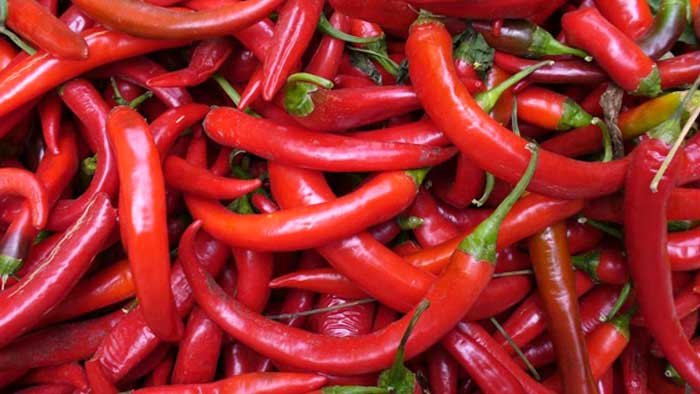Pepper is a cash crop in Bangladesh. It is used regularly in Bangladesh. Pepper is eaten in both raw and ripe two conditions. It is cultivated everywhere of Bangladesh. Pepper is not only used in spices or delicacy. Playing moderately and regularly, it provides vitamin A, B, C.
.jpg)
Uses: In addition to making cooking and appetizing food, pepper is also used as a compote of different types of rituals. Many people also practice chillies.
Wherever there is more quantity of cultivation: Barisal district greater in the field of marine cultivation is much ahead. Moreover, Bogra, Faridpur, Noakhali, Jamalpur, Meherpur, Barisal, Comilla, Chittagong and Mymensingh pepper is cultivated in abundance..jpg)
Known species: This type of pepper is found in sweet and sweet. Bogra, Chandpuri, Faridpuri are notable among the sour chillies. Besides, Kamranga, Akali and black pepper are very sour.
Plantation: The land is sown in a 3x1 meter siege by properly cultivating the land and by selecting ladders and weeds. Seeds are sown in the seed bed during the Bhadra-Chaitra month for the Bhadra-Ashwin month and monsoon season for the winter season. Seedling 10 cmIf high, it is suitable for planting.
Planting the seedlings: Planting of weeds is planted after preparation of 4-5 cultivation and ladders. Planting seedlings range from row to row 60-70 cm And the distance between the plants is 30-40 cm.Is kept. Saplings should be put in the afternoon and water will be given in the morning for 2-3 days.
Fertilizer management: In kerosene land, 10 hectares of cow dung, urea 250 kg, TSP 200 kg and MOP fertilizer 150 kg are applied per hectare. During the preparation of the land, all the dung, TSP and 50 kg of MOP fertilizers were applied. After 25 days of transplantation, 84 kg urea and 34 kg MOP fertilizers were applied on the first surface. After the first 50 days after planting, fertilizers applied to the third installment after the second and 70 days. In the 2nd and 3rd installments, 83 kg urea and 33 kg of MOP fertilizers were applied every time.
.jpg)
Irrigation and weed control: 4 to 5 days in summer and irrigation after 10 to 12 days in winter. Besides, irrigation after application of every installment is required. After a few days of irrigation, the soil will be broken if the flame appears, so that the roots get the necessary light and air. The tree growth is high in it. When the weeds appear, it should be cleaned and loose during the applying fertilizer.
Damage samples: Planting of leafy plants and adult trees, branches, flowers, fruits are affected. The infected leaves begin to drop and die on the tip. The affected plants become pale brown, weaken and fruit losses are reduced. Round spots on the fruit fall and there are dark yellow rings or rings around the scars. The stains continue to grow and fall apart. The affected plants die quickly. Wet weather and more rainfall help in the spread of the disease. The abandoned part of the tree, spread through air, water, etc. to be an alternative host. Besides, this disease spread through seeds and this disease.
Management: To collect seeds from healthy plants. The abandoned portion of the infected tree must be destroyed. After the approved fungus, seeds will be sown by cleaning the seeds. Only Tilt-250 EC (0.05%) Bavistin (0.1%) or Nine (0.2%) should be sprayed for 10 days after the attack of disease in the field.
After harvesting, chilli is usually cooler, shade and dry place 28th.There is no harm to the chilli if the temperature is kept at 60% relative humidity for 1 to 2 weeks.
Selection: After collecting the green chilli, you need to split it into two pieces of 'broken and crutches' and 'good'. Only good markets should be sold.
Dry pepper is sorted in two ways-
- Whitening and opening of boats can be kept for their use and 2) Only good to be stored.
Reservation method: The ripe fruit of the pepper is picked up from the tree, dried and stored. Drying fruits with sunlight is a common method in our country. But if you do not mind a little bit, the resultant sun shade results in whitish colors. If the rain or dew is collected due to the collection, 'fruit crank' diseases occur. During the drying of the chilli be careful not to leave the pepper bota so that special care should be taken. Pepper 650sKeeping the temperature in hot water for 3 minutes reduces the amount of drying of the fruit, so that the color of the pepper becomes increasing and the subsequent loss of the chilli is reduced. After drying the chilli, the top should be kept in tin dough, shell, berry, polythene or drum. The chilli should not be able to enter the air from outside. It is necessary to make chillies in the cells which are not covered in the shade of trees and are not located in a damp place.

Seed Production: Chilli farmers can easily produce seeds. However, during the production of seeds, it should be noted that there is no other chilly seed in the species of chilli at least 1300 feet. The seeds of mature, nutritious and bright red color must be collected from the pepper. Typically a pepper contains 70 to 75 seeds and 1000 seeds weighing around 5 grams. It is possible to produce 32 to 35 kg seeds per acre.
img credz: pixabay.com
Nice, you got a 86.0% @tincho upgoat, thanks to @ornima
Want a boost? Minnowbooster's got your back!
The @OriginalWorks bot has determined this post by @ornima to be original material and upvoted(2%) it!
To call @OriginalWorks, simply reply to any post with @originalworks or !originalworks in your message!
nice post
tnxxx
Nice hoyche!
nice
yes many people use it many ways
Nice,
Nice
Nice post